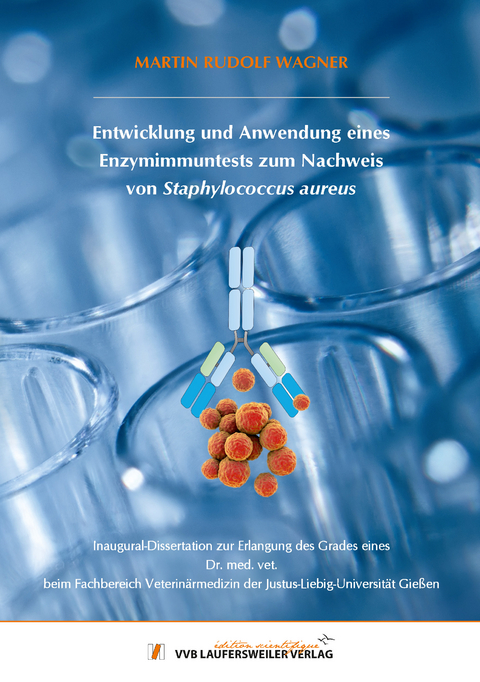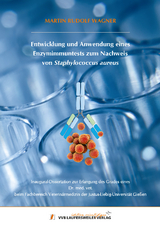Entwicklung und Anwendung eines Enzymimmuntests zum Nachweis von Staphylococcus aureus
Seiten
- Keine Verlagsinformationen verfügbar
- Artikel merken
Bakterien der Spezies Staphylococcus (S.) aureus sind von pathogener Art und können schwere Erkrankungen, sowohl gastrointestinaler, als auch extragastrointestinaler oder sogar systemischer Natur auslösen. In der vorliegenden Arbeit wurden gegen S. aureus gerichtete polyklonale Antikörper (pAk) hergestellt und unter Verwendung von biotinylierten pAk in einem Sandwich-Enzymimmuntest genutzt. Es wurde dadurch ein schneller und einfach durchzuführender Nachweis von S. aureus etabliert und charakterisiert.
Zunächst wurde eine gut beschriebene Stammsammlung an Staphylokokken-Isolaten und weiteren für die Lebensmittelsicherheit relevanten Keimen erstellt. Für das entwickelte enzymimmunologische Nachweisverfahren wurden pAk in Kaninchen gewonnen. Dafür wurden von vier S. aureus-Kulturen Keimpräparationen erstellt, diese mit Paraformaldehyd inaktiviert und für die Immunisierung von zwei Kaninchen genutzt. Diese gegen S. aureus gewonnenen Antiseren wurden gefällt und biotinyliert. In dem etablierten pAk-Sandwich-ELISA konnte eine Nachweisgrenze von 105 KbE/ml im nicht autoklavierten Ansatz bzw. 106 - 107 KbE/ml im autoklavierten Ansatz (121 ⁰C bei 2 bar für 20 min) realisiert werden. Es konnten im nicht autoklavierten Ansatz 120 von 127 (94,5 %) und im autoklavierten Ansatz 94 von 127 (74,0 %) der S. aureus-Isolate detektiert werden.
Um eine mögliche unspezifische Reaktion von SpA mit den produzierten IgG auszuschließen, wurde bei allen S. aureus-Kulturen mit einem EIA-Testsystem das SpA-Bildungsvermögen bestimmt und mit den Ergebnissen des pAk-S. aureus-ELISAs verglichen. Im nicht autoklavierten Ansatz konnte bei 118 von 127 S. aureus-Kulturen ein SpA-Bildungsvermögen dargestellt werden, wobei 98 % im pAk-S. aureus-ELISA positiv waren. Im autoklavierten Ansatz reduzierte sich der SpA-Nachweis auf 104 Isolate, hiervon waren 87,5 % im Sandwich-ELISA positiv. Es konnte eine Nachweisgrenze von 4 ng/ml mit einem chemisch modifizierten SpA erreicht werden. Zusätzlich wurde eine gute Detektion trotz sterischen Überlagerungen durch eine Absättigung mit unspezifischen Kaninchen-Immunserum erzielt.
Die Anwendbarkeit des entwickelten EIA-Testsystems für S. aureus wurde anhand künstlich kontaminierter UHT-Milch bzw. Rohmilchkäse überprüft. Es konnte eine Wiederfindungsrate von 100 % erreicht werden. Der Nachweis war, inkl. einer Voranreicherung von 18 h, innerhalb von 24 h möglich. Der in der vorliegenden Arbeit entwickelte Enzymimmuntest kann für den Nachweis von S. aureus, auch bei großen Probenmengen, verwendet werden und dadurch einen wichtigen Beitrag zur Verbesserung der Lebensmittelsicherheit in Bezug auf KPS leisten. Bacteria of the species Staphylococcus (S.) aureus are pathogenic and can cause serious diseases, both gastrointestinal and extragastrointestinal or even systemic. In this study polyclonal antibodies against S. aureus were prepared and used with biotinylated polyclonal antibodies in a sandwich enzyme immunoassay. A rapid and easy detection of S. aureus was established and characterized.
First a well-characterized collection of staphylococcal cultures and other relevant bacteria for food safety has been created. For the developed enzymimmunological detection method, pAk were obtained in rabbits. Out of four S. aureus cultures bacteria preparations were created, inactivated with paraformaldehyde and used for the immunization of two rabbits. These antiserums against S. aureus were precipitated and biotinylated. In the established polyclonal sandwich ELISA, a detection limit of 105 cfu/ml was realized in the non-autoclaved approach, respectively 106 - 107 cfu/ml in the autoclaved approach (121 ⁰C/2 bar/20 min). In the non-autoclaved approach 120 out of 127 (94,5 %) and in the autoclaved approach 94 out of 127 (74,0 %) of the S. aureus-isolates were identified.
To avoid a non-specific reaction of SpA produced by most S. aureus-cultures with the IgG, the SpA of all coagulase-positive staphylococci were determined with an EIA test system and compared with the results of the established polyclonal ELISA for detection of S. aureus. The non-autoclaved approach showed a production of SpA in 118 out of 127 of the S. aureus-cultures, out of which 98 % were positive in the polyclonal ELISA for detection of S. aureus. In the autoclaved approach the production of SpA decreased to 104 isolates, of which 87,5 % were positive. A detection limit of 4 ng/ml could be reached with a chemically modified SpA. In addition, a good detection was achieved despite the steric overlays of a saturation with nonspecific rabbit serum.
The applicability of the developed EIA-test-system for S. aureus was verified using artificially contaminated UHT milk and raw milk cheese. A 100 % recovery rate was achieved. Including a pre-enrichment of 18 h, the results were available within 24 h. The enzymimmunological test developed in this work can be used for the detection of S. aureus – even for large sample - and can thus make an important contribution to improve food safety regarding coagulase-positive staphylococci.
Zunächst wurde eine gut beschriebene Stammsammlung an Staphylokokken-Isolaten und weiteren für die Lebensmittelsicherheit relevanten Keimen erstellt. Für das entwickelte enzymimmunologische Nachweisverfahren wurden pAk in Kaninchen gewonnen. Dafür wurden von vier S. aureus-Kulturen Keimpräparationen erstellt, diese mit Paraformaldehyd inaktiviert und für die Immunisierung von zwei Kaninchen genutzt. Diese gegen S. aureus gewonnenen Antiseren wurden gefällt und biotinyliert. In dem etablierten pAk-Sandwich-ELISA konnte eine Nachweisgrenze von 105 KbE/ml im nicht autoklavierten Ansatz bzw. 106 - 107 KbE/ml im autoklavierten Ansatz (121 ⁰C bei 2 bar für 20 min) realisiert werden. Es konnten im nicht autoklavierten Ansatz 120 von 127 (94,5 %) und im autoklavierten Ansatz 94 von 127 (74,0 %) der S. aureus-Isolate detektiert werden.
Um eine mögliche unspezifische Reaktion von SpA mit den produzierten IgG auszuschließen, wurde bei allen S. aureus-Kulturen mit einem EIA-Testsystem das SpA-Bildungsvermögen bestimmt und mit den Ergebnissen des pAk-S. aureus-ELISAs verglichen. Im nicht autoklavierten Ansatz konnte bei 118 von 127 S. aureus-Kulturen ein SpA-Bildungsvermögen dargestellt werden, wobei 98 % im pAk-S. aureus-ELISA positiv waren. Im autoklavierten Ansatz reduzierte sich der SpA-Nachweis auf 104 Isolate, hiervon waren 87,5 % im Sandwich-ELISA positiv. Es konnte eine Nachweisgrenze von 4 ng/ml mit einem chemisch modifizierten SpA erreicht werden. Zusätzlich wurde eine gute Detektion trotz sterischen Überlagerungen durch eine Absättigung mit unspezifischen Kaninchen-Immunserum erzielt.
Die Anwendbarkeit des entwickelten EIA-Testsystems für S. aureus wurde anhand künstlich kontaminierter UHT-Milch bzw. Rohmilchkäse überprüft. Es konnte eine Wiederfindungsrate von 100 % erreicht werden. Der Nachweis war, inkl. einer Voranreicherung von 18 h, innerhalb von 24 h möglich. Der in der vorliegenden Arbeit entwickelte Enzymimmuntest kann für den Nachweis von S. aureus, auch bei großen Probenmengen, verwendet werden und dadurch einen wichtigen Beitrag zur Verbesserung der Lebensmittelsicherheit in Bezug auf KPS leisten. Bacteria of the species Staphylococcus (S.) aureus are pathogenic and can cause serious diseases, both gastrointestinal and extragastrointestinal or even systemic. In this study polyclonal antibodies against S. aureus were prepared and used with biotinylated polyclonal antibodies in a sandwich enzyme immunoassay. A rapid and easy detection of S. aureus was established and characterized.
First a well-characterized collection of staphylococcal cultures and other relevant bacteria for food safety has been created. For the developed enzymimmunological detection method, pAk were obtained in rabbits. Out of four S. aureus cultures bacteria preparations were created, inactivated with paraformaldehyde and used for the immunization of two rabbits. These antiserums against S. aureus were precipitated and biotinylated. In the established polyclonal sandwich ELISA, a detection limit of 105 cfu/ml was realized in the non-autoclaved approach, respectively 106 - 107 cfu/ml in the autoclaved approach (121 ⁰C/2 bar/20 min). In the non-autoclaved approach 120 out of 127 (94,5 %) and in the autoclaved approach 94 out of 127 (74,0 %) of the S. aureus-isolates were identified.
To avoid a non-specific reaction of SpA produced by most S. aureus-cultures with the IgG, the SpA of all coagulase-positive staphylococci were determined with an EIA test system and compared with the results of the established polyclonal ELISA for detection of S. aureus. The non-autoclaved approach showed a production of SpA in 118 out of 127 of the S. aureus-cultures, out of which 98 % were positive in the polyclonal ELISA for detection of S. aureus. In the autoclaved approach the production of SpA decreased to 104 isolates, of which 87,5 % were positive. A detection limit of 4 ng/ml could be reached with a chemically modified SpA. In addition, a good detection was achieved despite the steric overlays of a saturation with nonspecific rabbit serum.
The applicability of the developed EIA-test-system for S. aureus was verified using artificially contaminated UHT milk and raw milk cheese. A 100 % recovery rate was achieved. Including a pre-enrichment of 18 h, the results were available within 24 h. The enzymimmunological test developed in this work can be used for the detection of S. aureus – even for large sample - and can thus make an important contribution to improve food safety regarding coagulase-positive staphylococci.
| Erscheinungsdatum | 01.02.2022 |
|---|---|
| Reihe/Serie | Edition Scientifique |
| Verlagsort | Gießen |
| Sprache | deutsch |
| Maße | 148 x 210 mm |
| Gewicht | 320 g |
| Themenwelt | Veterinärmedizin ► Allgemein |
| Schlagworte | Bakterien • Staphylococcus (S.) aureus • Toxikologie |
| ISBN-13 | 9783835969421 / 9783835969421 |
| Zustand | Neuware |
| Informationen gemäß Produktsicherheitsverordnung (GPSR) | |
| Haben Sie eine Frage zum Produkt? |
Mehr entdecken
aus dem Bereich
aus dem Bereich
Buch | Softcover (2025)
Mensch & Buch (Verlag)
CHF 69,85


